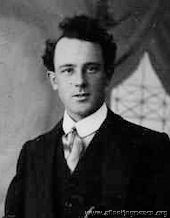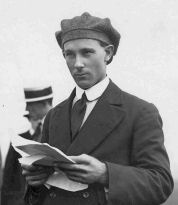| Mr Harry George Hawker MBE, AFC | ||
|
in 1912, aged 23 |
|
|
|
b. 22 Jan 1889 in Victoria, Australia; son of a blacksmith, and the co-founder of Hawker Aircraft. A very early flier - RAeC Certificate No 297, in 1912. The following year, he made 5 flights 'on and off water' in a Sopwith-designed seaplane, which meant that they won the £500 offered by the RAeC. An even bigger prize in 1913 was the £5,000 offered by the Daily Mail for a race for seaplanes, to cover nearly 1600 miles in 72 hours round the coast of Britain. Harry (with fellow Australian H Kauper as mechanic) started off in a Sopwith from Southampton on August 16th. They got as far as Yarmouth but Harry felt unwell (later they worked out that he had sunstroke) and had to return to Southampton for another try, which started on the 26th. Unfortunately, having made good progress on their first day, nearing Dublin on the second his foot slipped off the rudder bar, the aeroplane fell "like a stone" and dumped them in the Irish Sea, whence they had to be rescued by the Coastguard; the machine was wrecked. Harry was unhurt, Mr Kauper injured. The Daily Mail gave them a consolation prize of £1,000 "in recognition of their plucky attempt". A few weeks later, he wrote off another Sopwith at Brooklands, badly injuring his back. The following year he did it again in almost the same place, this time failing to control a loop and spinning down into some trees. When spectators reached the scene, Harry was standing by the smashed aeroplane, "bewildered but unhurt". Nothing daunted, he broke the British altitude record by climbing to 18,393ft in 1915, although it took him over an hour and he" suffered greatly from the cold"; he then broke the world record by getting to 24,408ft on 26 April 1916 (which started people wondering about perhaps flying to the top of Everest). Next, in 1919, the Daily Mail offered £10,000 for a flight across the Atlantic. Harry, with Commander Kenneth Mackenzie Grieve R.N. as navigator, started from Newfoundland on 18th May but the aeroplane had problems with its radiator and they had to put down in the sea after about 800 miles. It was several days before the news emerged that they had been rescued by the small steamer 'Mary', and taken to Thurso. The Nation, having feared the worst, was mightily relieved, and gave them a terrific welcome; "No event since the Armistice has so stirred the popular imagination". Harry and Kenneth got the Air Froce Cross each (despite the fact that Harry wasn't actually in the Air Force), and £2,500 each as a not-inconsiderable consolation prize (although they had agreed to split the original prize 70:30). Before they could try again (on June 15th to be precise), Alcock and Brown had done it (just), been knighted by Mr Churchill and walked off with the cheque for £10k. Damn! His luck finally ran out when he was killed in the Nieuport Goshawk G-EASK which crashed at Hendon 12 July 1921 while he was preparing for that year's Aerial Derby. The aeroplane burst into flames and spun in; Harry leapt from (or fell out of) the plane and was found some distance from its remains, "quite dead". |
||



